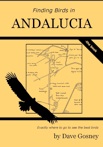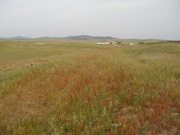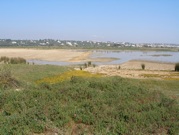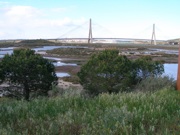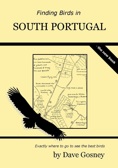Finding Birds in South Portugal update
Algarve
Jan 2014 Just to endorse what DG says in his intro that almost anywhere on the Algarve you will be close to great wetland habitat - We are just back from a week's holiday near Portimao and spent most mornings watching the pools and the tidal river at Parchal on the other side of the river Arade from Portimao. Great birding! In addition to a wintering Marsh Sandpiper (seen three times) we had max counts of 52 White Storks, 35 Greater Flamingo, 27 Spoonbill, 7 Cattle Egret, 7 Black-winged Stilt, as well as Black-necked Grebe, Caspian Tern, Audouin's Gull, Whimbrel, Bluethroat, Kingfisher, Little Owl, Serin, Iberian Chiffchaff etc. Even a Great Skua at the river mouth. (Andy Thomas)
12 May 2014 Santo Estevao near Tavira: brilliant location around our villa "Vila dois Iramaos". 3 Black winged kite regular each morning in clearing from the village head down the hill to the junction turn left and continue until clearing on right. Morning visits reliable. Also in the area: Hoopoe, Bee-eater, Golden Oriole, Azure winged magpie, Waxbills, Serins,Sardinian warblers, redstart, lesser spotted woodpecker, Iberian Green woodpecker, Woodchat shrikes. Zitting Cisticola, Crested larks, Red necked Nightjars every night. Best of all for the area on the 15th Orphean warbler along track to villa in scrub vegetation chased by Sardinian warbler. (Kevin Kelly)
May 2019 In Tavira, each evening at dusk Red-necked Nightjars proved easy to find as they hawked around the floodlit Igresia de Santiago which is next to Tavira Castle in the middle of the town (Ken Wiles).
January 2023 Salinas de Olhao. Brian Jones recommends the saltpans at the west end of Olhao town which can be accessed from the bend of 5 Octubre road (37.0232N, 7.8503W). He says it has many more birds than the other Olhao reserve (page 28, site 2). There are no hides or route maps but it’s easy to find your way around.
Ria Formosa west
13-20 January 2013 5 Booted Eagle at site 3 all week, over marsh and in eucalyptus trees next to salt pans near the farm buildings. Also Marsh Harrier and Bluethroat noted. (Paul Lathbury)
3rd Oct 2013 Usual Little Bittern, Glossy Ibis and Swamphens at site 6 plus Black Terns. Mixed flock of storks and herons at site 5 included a Sacred Ibis (DG)
December 2016 Male and female Little Bittern here even in winter (Greg Holmes)
January 2019 Several Bluethroat, 2 Caspian Tern, Purple Gallinules(site 6), 2 Black-shouldered Kites, a roost of 10-15 Booted Eagles just east of site 3, Osprey at the river itself (Bertus de Lange)
December 2019 Red-knobbed Coot reported by other birders at site 6. (Greg Holmes)
Alvor estuary
December 2019 The sea wall at Alvor marsh has been breached and it is a catastrophe, must be a 10 metre gap, the area is subject to 2 tides a day, never seen so many dead snails. (Greg Holmes)
Cabo de Sao Vicente/Sagres
12 Oct 2009 Black Stork (6), Egyptian Vulture (5), Booted Eagle (6), Bonelli's Eagle (2), Black Kite, Red Kite (1), Hen Harrier (1), Common Buzzard, Honey Buzzard, Sparrowhawk (10), Hobby (1), Peregrine, Lapwing (5), Thekla Lark, Woodlark (10), Tree Pipit (1), Grey Wagtail (2), Black Redstart (1), Blue Rock Thrush (1), Crested Tit (1), Azure-Winged Magpie (8), Spotless Starling, Chaffinch (2), Corn Bunting. At site 5 Redstart, Reed Warbler and Garden Warbler (R Powell trip report on www.travellingbirdercom)
5th Oct 2013. Pelagic trip unusually poor since no fishing boats present within range of zodiac. Just 1 Storm Petrel, 2 Great skuas and and few Balearic and Cory's Shearwaters. However, the next boat out found a 'bait ball' of swirling fish which attracted over 100 Common Dolphin and birds such as 15 Wilson's Petrel and some Sooty Shearwaters. Raptor migration from site 5 excellent with dozens of Short-toed and Booted Eagles and Sparrowhawks plus Hobby, Peregrine, Merlin, Black Stork, Marsh Harrier, Common Buzzard and a Black-shouldered Kite. Lots of passerines too, especially Willow Warblers and flycatchers
January 2019 A few gannets and shags, up to 50 crag martin, 2 blue rock-thrush and a lot of people. Scenic place. (Bertus de Lange)
Barroca d'Alva
14 April 2011 Yellow-crowned Bishop and Black-headed Weaver (nesting) were both easily located at site 1. Also a pair of Little Bitterns in the channel and 75 Glossy Ibis and 20 spoonbills flying over.As far as I know there were no confirmed sightings of Black-headed Munia at site 4 in 2010, though I had them here in May 2009 (Richard Bonser, trip report at www.travellingbirder.co.uk)
6th Sept 2011. Black-headed Weaver, Yellow-crowned Bishop and Common Waxbill were pretty conspicuous but no Black-headed Munia were seen. Also Black-shouldered Kite at both Barroca d'Alva and Rilvas (Paul Chapman in trip report on www.birdforum.net)
Late March 2019 Site 1- Only waxbills and didn’t find any other exotics at the other sites. There were thousands of glossy ibis in the recently ploughed fields in the area. Hundreds kept pouring out of the sky and probably close to 4000 (Matt Busuttil)
Castro Verde plains
4th Oct 2013. With guides from LPN we were able to drive from Guerreiro to Sao Marcos through the LPN reserve. It was great for Black-bellied Sandgrouse and Great Bustard and we had Black Vulture, Griffon vulture and Spanish Imperial Eagle overhead. No Little Bustards or BS Kites. Many Little Bustard and most adult male Great Bustards leave the Castro Verde area at the end of the breeding season. (DG)
2013 Perhaps the most reliable site in Portugal for White-rumped Swift is at Mina de Sao Domingos (37.668N, 7.501W) about 15 km east of Mertola. Little Swift has been seen here too. To get there, cross the Rio Guadiana at Martola and continue until you reach the mines. (DG)
2013 A good site for Rufous Bush Robin is the bridge (37.7080N, 7.8619W) on the road to Monte de Legua. Drive east from Sao Marcos on the N123 for 7km then turn right. The bridge comes after 1 km. Black-bellied Sandgrouse are sometimes seen from this road too. (LPN per DG)
22nd April 2015 Just north of the plains is the Lagoa dos Patos, 22 km NW of Beja (38.1604N, 8.0630W). Birds here included 9 Gull-billed Tern, 3 Black Tern, Spoonbill and a Red-throated Pipit (Chris Stone)
Late Sept 2014 Fantastic views of Great Bustards (close range, great light) by the cemetery at site 4, as described (DG)
December 2016 It is no longer possible to access the LPN visitor centre at site 2 by turning off the IP2 at km 384 (37.7328N, 8.0569W) due to a new road barrier. Instead you must continue to Entradas and turn first right and right again to follow the track back parallel to the IP2 for almost 4 km to reach the turning to the centre (all these tracks are shown on the map on page 35). The LPN are working to overcome this new difficulty so access could change again in the future. (Gianluigi Castelli)
December 2016 The route via Entradas is blocked too; the access is now by entering Castro Verde and taking the first left after the firestation (Bombaderiaos), easy really once found (Greg Holmes). This was still the situation in September 2018.
January 2019 Great birding with around 100 Great Bustard (several flocks), 2 flocks of Little Bustard (35 and 75/80), Spanish Imperial Eagle, Black Vulture, Black-bellied Sandgrouse, Common Cranes etc.
Some places were really good, especially the area's north and east of site7, the area's north-east and south-east of sites 4 and 5; there is road from Monte Salto to Corte Pequena (east of Monte Salto) which is well-signposted with great bustard signs. Very good! (Bertus de Lange)
Late March 2019 Site 6 - Several Great Bustards seen here on the slopes and in flight. Site 7- Great Bustard displaying and several Little Bustard seen here, 7 Black Bellied Sandgrouse flew over, and Griffon Vulture seen. On the way to this site just out of the village Guerriero a Spanish Imperial Eagle flew over (Matt Busuttil)
Elvas
Late March 2019 Site 2 - Black Shouldered Kite seen easily further down the road in the oaks on the left about 300 metres before the reservoir. Also Southern Grey Shrike and Quail (heard) (Matt Busuttil)
Castro Marim
3rd Oct 2013 Correction: You CAN walk along the track towards the salt pans at site 1; the no entry sign applies to vehicles not pedestrians but you MUST keep to the track. This will make it much easier to find the Lesser Short-toed Larks. Pools near the saltworks at site 3 had lots of waders; 14 Ravens flying over was exceptional (DG)
Portas do Rodao
11 April 2011 At 3.30 pm we could see the Ruppell's Vulture perched on the cliff from the lay-by [shown as 'another vantage point on the map']. At 4pm we had views of it in flight from the viewing platform (Richard Bonser, trip report at www.travellingbirder.co.uk)
27th Aug 2011 The vulture remained perched on the cliffs for 5 hours apart from 2 brief flights (Jonathan Dean in trip report on birdforum.net)
6th September 2011 The vulture was constantly in view from 3pm to 6pm on the cliffs opposite the viewpoint (Paul Chapman on birdforum.net)
Lago de Salgados
15th Sept 2013 200 Greater Flamingos, 60 White Storks, 12 Spoonbills, 6 Cattle Egrets, 10 Little Egrets, Caspian Tern, Whiskered Tern, Marsh Harrier, 10 Black-winged Stilts, 5 Curlew Sandpipers, mixed flock of Dunlin/Sanderling/Ringed Plover/Kentish Plover, 3 Shelducks, 2 Fan-tailed Warblers and 2 Crested Larks. (Brian Stretch)
6th October 2013 The area close to the car park at site 1 was completely dry due to creation of new bank isolating it from rest of pool. This is part of a planned management scheme with help from rspb. Eventually the area within the bank will have water levels managed for birds. until then best views are from the observation platform at site 2 - currently lots of waders, storks, flamingoes, spoonbills, gulls etc. Melanistic Montagu's Harrier flew over. (DG)
27th Sept 2014 2 Caspian Terns, 20+ Flamingos, 5 Spoonbills. Several Common Waxbills around near-by Gale. (Mark Hawkes)
Vilamoura
30th Nov 2009 At site 4, 1 Little Bittern, 1 Purple Heron, 1 Squacco Heron and 11 Night herons flushed by a low-flying Booted Eagle as well as several Marsh Harriers, a Black- shouldered Kite, Caspian and Little Terns, Med Gull, Purple Swamphen and Ferruginous Duck. I didn't see Penduline Tit but they would certainly have been there. (Colin Key in blog on algarvebirder.blogspot.com)
July-Aug 2 Little Bustards seen on Aug 6th. daily visits produced 2 Black-shouldered Kite each day as well as many Little Bitterns, Night Herons, Purple swamp Hen, Purple Herons. Feruginous Ducks, Red-crested Pochard, Red-necked Nightjar, waxbills, Black-headed weavers, Great Reed Warblers, Stone Curlews, Cetti's Warblers, Quails and usual Mediterranean species.
15th Oct 2013 Water treatment pools at site 5 held lots of birds especially flocks of Little Grebe. Also 1 Black-necked Grebe and dozens of red-rumped swallows over the water. Black-shouldered kite on wire from track to site 5. (DG)
Mount Foia (Monchique)
11th May 2014 The mountain side was covered in spring flowers,saw blue rock thrush and rock bunting,heard nightingale but couldn't see it. Arrive as early as you can , by 10.30 it was crowded with coaches. (J Walker)
November 2018 Almost birdless due to the recent fires which have decimated huge areas. (Berkeley Thomas)
January 2019 5+ Rock Bunting (on the terrace of the restaurant), Blue Rock Thrush, Crag Martin; excellent views of both Dartford and Sardinian Warbler, feeding in the grassy area's! (Bertus de Lange)
Carvoeira headland
The headland 10 km west of Pera marsh. Accessed by turning south from the N125 at Lagoa
15th October 2009 Cory's Shearwater (20), Balearic Shearwater (18), Mediterranean Gull (1) (R Powell trip report on www.travellingbirdercom)
Sado estuary
September 2018 Roy and Cathy Collins got to within 1 km of Pinheiro only to find their way barred by security guards who explained that Pinheiro is privately owned and access would not be allowed. This was despite following a public road, (well a very dusty white sandy unpaved track, through fenced woodland) for 8Km with all side turnings fenced off.
January 2019 Impressive birding at sites 5-6-7; up to 5 bluethroat, 1000's glossy ibis, big flocks of waders (avocet, whimbrel, dunlin, grey plover etc), several spoonbill. Also black-shouldered kite in that area.(Bertus de Lange)
Late March 2019 Site 2 - Parked up just off the Road to walk down to the bridge over the river to Zambujal. Scaly-breasted Munia seen twice flitting between the trees on either side of the track near where we parked. Short toed eagle over the river by the bridge, Crested Tit and Iberian Chiffchaff 3-400 metres beyond the bridge but no other exotics seen in this area (Matt Busuttil).
Late March 2019 There is a reserve Moinho de Mare da Mourisca, (7 km east of Setubal signposted from the village Mourisca) that was worth a visit - several Kentish Plover and Little Stint along with other waders and Waxbills in the car park. Purple Swamphen can be seen there apparently (Matt Busuttil).
Tejo Estruary
Late March 2019 Site 1- Ponta de Erva- pretty quiet. Plenty of Hen and Marsh Harriers about but no other raptors. Site 7 - Crested Mynahs seen near the car park (Matt Busuttil)
Santo Andre lagoons
January 2019 A lot of coots, a few black-necked grebes; a lot of waxbill and singing cirl bunting. Not recommended. (Bertus de Lange)
Finding Birds in South Portugal

